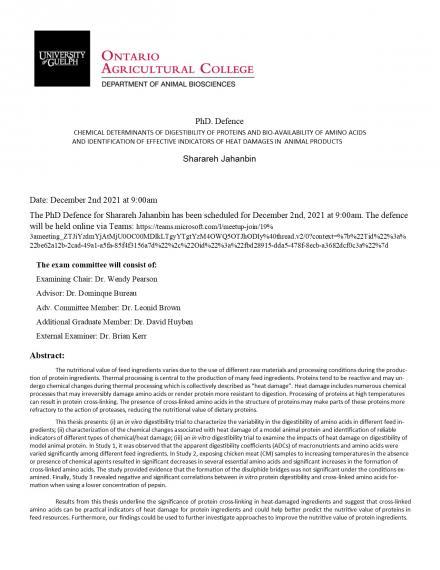Sharareh Jahanbin's PhD Defence
Date and Time
Location
Teams: https://teams.microsoft.com/l/meetup-join/19%3ameeting_ZTJiYzdmYjAtMjU0OC00MDlkLTgyYTgtYzM4OWQ5OTJhODIy%40thread.v2/0?context=%7b%22Tid%22%3a%22be62a12b-2cad-49a1-a5fa-85f4f3156a7d%22%2c%22Oid%22%3a%22fbd28915-dda5-478f-8ecb-a3682dcf0c3a%22%7d

Details
The nutritional value of feed ingredients varies due to the use of different raw materials and processing conditions during the produc-tion of protein ingredients. Thermal processing is central to the production of many feed ingredients. Proteins tend to be reactive and may un-dergo chemical changes during thermal processing which is collectively described as “heat damage”. Heat damage includes numerous chemical processes that may irreversibly damage amino acids or render protein more resistant to digestion. Processing of proteins at high temperatures can result in protein cross-linking. The presence of cross-linked amino acids in the structure of proteins may make parts of these proteins more refractory to the action of proteases, reducing the nutritional value of dietary proteins.
This thesis presents: (i) an in vivo digestibility trial to characterize the variability in the digestibility of amino acids in different feed in-gredients; (ii) characterization of the chemical changes associated with heat damage of a model animal protein and identification of reliable indicators of different types of chemical/heat damage; (iii) an in vitro digestibility trial to examine the impacts of heat damage on digestibility of model animal protein. In Study 1, it was observed that the apparent digestibility coefficients (ADCs) of macronutrients and amino acids were varied significantly among different feed ingredients. In Study 2, exposing chicken meat (CM) samples to increasing temperatures in the absence or presence of chemical agents resulted in significant decreases in several essential amino acids and significant increases in the formation of cross-linked amino acids. The study provided evidence that the formation of the disulphide bridges was not significant under the conditions ex-amined. Finally, Study 3 revealed negative and significant correlations between in vitro protein digestibility and cross-linked amino acids for-mation when using a lower concentration of pepsin.
Results from this thesis underline the significance of protein cross-linking in heat-damaged ingredients and suggest that cross-linked amino acids can be practical indicators of heat damage for protein ingredients and could help better predict the nutritive value of proteins in feed resources. Furthermore, our findings could be used to further investigate approaches to improve the nutritive value of protein ingredients.